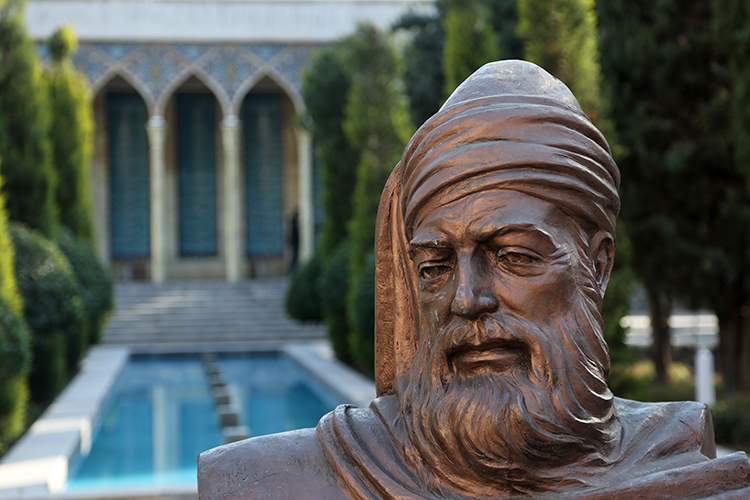
Famous Turkish Poet Saib-i Tabrizi
Famous Turkish Poet Saib-i Tabrizi
The mausoleum of Saib-i Tabrizi, one of the prominent Turkish poets of the 17th century, attracts attention both with its architecture and its natural surroundings.
Isfahan has historically been a center where many great poets and artists have emerged. One of the most significant symbols that make this city special for literature enthusiasts is the house and the tomb of Saib-i Tabrizi, a great Turkish poet of the 17th century, located within a vast garden.
Recognized as one of the greatest masters of classical lyrical poetry, Saib-i Tabrizi made significant contributions to literature, particularly through his mystical poetry and literary works, leaving a lasting impact on both Turkish and Persian literature.
Today, his tomb is not only a monument but also a place that carries traces of his life. The large and lush garden surrounding the tomb reflects the space where the poet found inner peace, contemplated, and wrote.
Saib lived in this place for many years, continuing his literary work and penning deep mystical thoughts. Over time, his house was transformed into a shrine and has been preserved as a sign of respect for him.
Located within a large garden that harmonizes with Isfahan’s historical fabric, the mausoleum is surrounded by flowers, green spaces, and a central pool, enhancing the beauty of the site. The vast garden attracts attention both architecturally and naturally.
The Mausoleum of Saib-i Tabrizi: A Simple Yet Impressive Structure
The pool within the garden was also a source of aesthetics and tranquility during the poet’s time. Reflecting traditional Iranian garden architecture, the pool enhances the peaceful atmosphere of the site. Water, considered a symbol in Sufi thought, is also present in Saib-i Tabrizi’s poetry. The pool in the middle of the garden creates an environment that brings peace to visitors while forming a point where nature and literature merge.
The mausoleum of Saib-i Tabrizi has a simple yet impressive design. The details reflecting the poet’s life and literature draw attention. Inscriptions on the walls, featuring excerpts from his poetry, offer visitors insights into his thoughts. Though in an open space, the intricately crafted ceiling of the tomb captivates the eye.
Considered a site that contributes to Isfahan’s historical and cultural richness, the transformation of the poet’s residence into a shrine and its presentation to visitors alongside the vast surrounding garden not only keeps Saib-i Tabrizi’s memory alive but also symbolizes respect for him.
According to Erfan Salihi, an expert from the Iranian Ministry of Tourism, Cultural Heritage, and Handicrafts, Saib-i Tabrizi moved from Tabriz to Isfahan with his family during the Safavid era and spent his life there.
Salihi stated that the area housing Saib’s final resting place was once his home and garden, adding, “He was buried here. Later, in 1963, during the reign of Shah Mohammad Reza Pahlavi, Saib-i Tabrizi’s mausoleum was built.”
He also noted that the tomb underwent restoration processes, saying, “It was restored twice—first in 2002 and then again in 2017, bringing it to its current form.”
Saib-i Tabrizi’s Place in Turkish and Persian Literature
Prof. Dr. Israfil Babacan, a faculty member at Ankara Yıldırım Beyazıt University, discussed Saib-i Tabrizi’s life and literary significance, stating that apart from Shamlou-ye Heravi, no historian or biographer has provided a clear account of his birthplace.
Heravi mentioned that Saib was born in Tabriz, Babacan explained, but the idea that he was born in Isfahan, where he lived for a long time, is also widely accepted.
Babacan noted that Saib’s father belonged to a well-established merchant family from Tabriz, saying, “In the Islamic year 1012, Saib’s father migrated to Isfahan along with other Tabrizi merchants invited by Shah Abbas, who aimed to establish a grand and prosperous capital.
Saib, in his late twenties, like many Iranian poets of his time, traveled to India and resided there for about nine years. Upon his return, he received great admiration from Safavid rulers during the reigns of Shah Safi, Shah Abbas II, and Shah Suleiman.”
For this reason, Babacan emphasized that Saib-i Tabrizi’s life in Isfahan is divided into two periods—before and after his time in India.
Although he primarily composed his poetry in Persian, Saib-i Tabrizi also garnered significant attention in Turkish literature. Babacan remarked, “Not only was he of Turkish origin, but his use of Persian with a Turkish thought structure and syntax, as well as his rich mystical and didactic poetry, attracted perhaps even more interest among Ottoman intellectuals than in Iran.”
According to Babacan, as far as current findings indicate, Saib’s poems have been analyzed and interpreted by five different individuals, including the great Ottoman commentator Ebubekir Nusret and the late Ottoman intellectual, historian, and statesman Ahmet Cevdet Pasha.
Source: Vedat Kurt